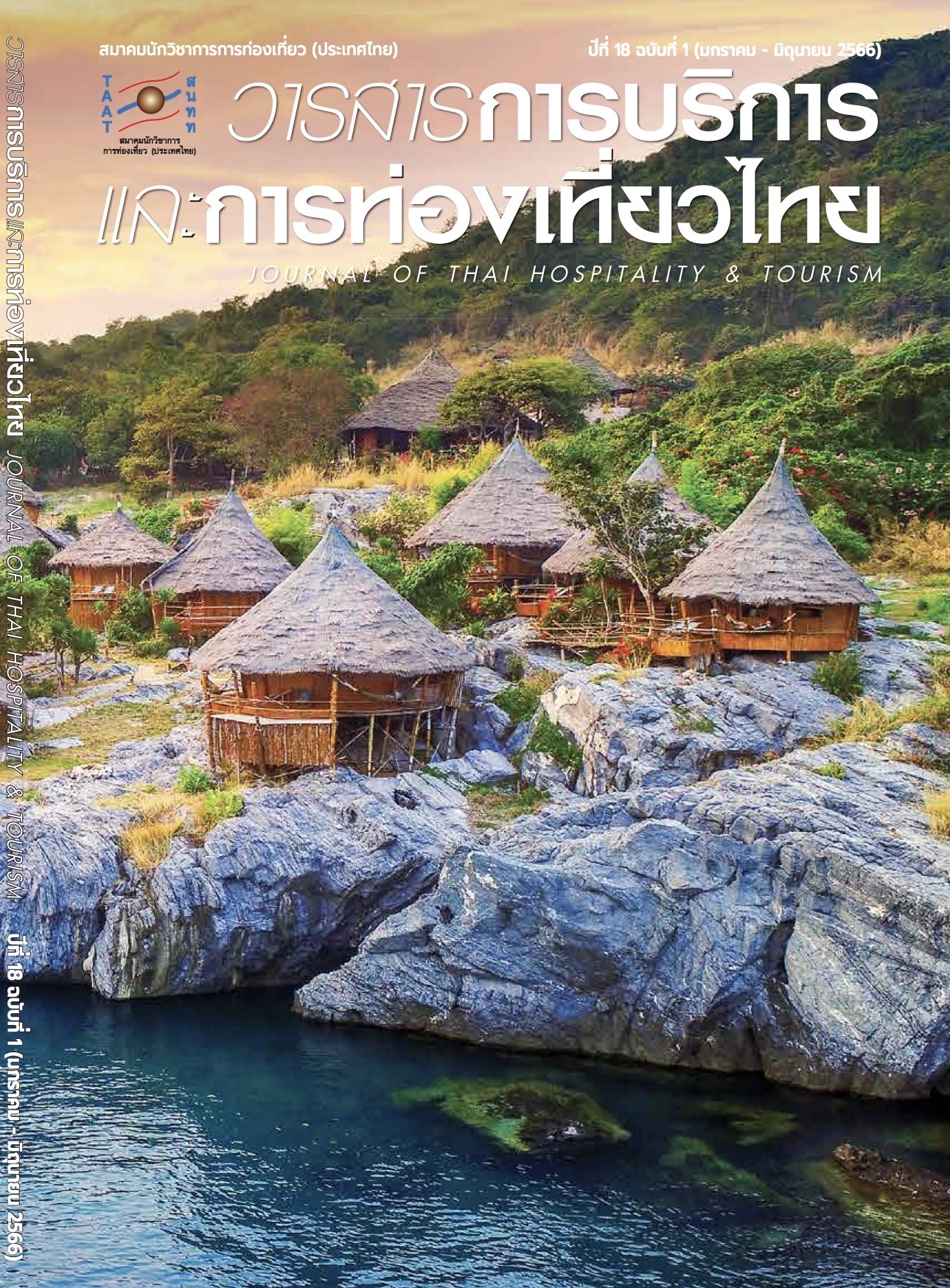การวิเคราะห์เส้นทางปัจจัยองค์ประกอบ ศักยภาพในการดึงดูดใจและการรองรับด้านการท่องเที่ยวที่ส่งผลต่อการบริหารจัดการแหล่งท่องเที่ยวทางประวัติศาสตร์ในจังหวัดปราจีนบุรี
Main Article Content
บทคัดย่อ
งานวิจัยครั้งนี้ มีวัตถุประสงค์เพื่อวิเคราะห์เส้นทางปัจจัยที่ส่งผลต่อการบริหารจัดการแหล่งท่องเที่ยวทางประวัติศาสตร์ในจังหวัดปราจีนบุรี กลุ่มตัวอย่างคือ นักท่องเที่ยวที่มาท่องเที่ยวในจังหวัดปราจีนบุรีจำนวน 400 ราย ใช้เทคนิคการสุ่มตัวอย่างแบบเจาะจง และใช้แบบสอบถามเป็นเครื่องมือในการเก็บข้อมูล วิเคราะห์ข้อมูลด้วยสถิติพื้นฐาน ประกอบด้วยค่าความถี่ ค่าร้อยละ ค่าเฉลี่ย ค่าส่วนเบี่ยงเบนมาตรฐาน และการวิเคราะห์เส้นทางปัจจัย
ผลการวิจัยพบว่า โมเดลเส้นทางปัจจัยสอดคล้องกับข้อมูลเชิงประจักษ์ ซึ่งมีค่า χ2/df เท่ากับ 1.855, p-Value เท่ากับ 0.173, GFI เท่ากับ 0.998, AGFI เท่ากับ 0.997, CFI เท่ากับ 0.999, NFI เท่ากับ 0.998, RMR เท่ากับ 0.003, RMSEA เท่ากับ 0.046 และ TLI เท่ากับ 0.994 เป็นไปตามเกณฑ์พิจารณาความสอดคล้องในระดับดี และการบริหารจัดการแหล่งท่องเที่ยวทางประวัติศาสตร์ในจังหวัดปราจีนบุรี ได้รับอิทธิพลรวมสูงสุดจากองค์ประกอบของการท่องเที่ยว รองลงมาคือ ศักยภาพในการรองรับด้านการท่องเที่ยว ศักยภาพในการดึงดูดใจด้านการท่องเที่ยว เมื่อพิจารณาค่าอิทธิพลของเส้นทางพบว่า องค์ประกอบของการท่องเที่ยว ศักยภาพในการดึงดูดใจและการรองรับด้านการท่องเที่ยวมีอิทธิพลทางตรงเชิงบวกต่อการบริหารจัดการ สำหรับอิทธิพลทางอ้อมพบว่า องค์ประกอบของการท่องเที่ยวมีอิทธิพลต่อการบริหารจัดการ ซึ่งเป็นอิทธิพลทางอ้อมที่ส่งผ่านตัวแปร ศักยภาพในการดึงดูดใจและการรองรับด้านการท่องเที่ยวมีค่า (p < 0.001) และตัวแปรทั้งหมดร่วมกันอธิบายความสัมพันธ์ที่เกิดขึ้นกับการบริหารจัดการอยู่ในระดับสูง
Article Details

อนุญาตภายใต้เงื่อนไข Creative Commons Attribution-NonCommercial-NoDerivatives 4.0 International License.
เอกสารอ้างอิง
Aquino, R. S. (2020). Book Review: Dolezal, C., Trupp, A. & Bui, H. T. (Eds.). (2020). Tourism and Development in Southeast Asia. Austrian Journal of Southeast–East Asian Studies, 13(1), 161–164.
Bayih, B. E. & Singh, A. (2020). Modeling Domestic Tourism: Motivations, Satisfaction and Tourist Behavioral Intentions. Heliyon, 6(9), e04839.
Boonyaphak, W. (2007). Potential in Cultural Tourism. Thailand Research Fund.
Buhalis, D. (2000). Marketing the Competitive Destination of the Future. Tourism Management, 21(1), 97–116.
Calero, C. & Turner, L. W. (2020). Regional Economic Development and Tourism: A Literature Review to Highlight Future Directions for Regional Tourism Research. Tourism Economics, 26(1), 3–26.
Chuaybumrung, T. (2009). Role of Local Government Organization and Sustainable Tourism Development Based on the Concept of Sufficiency Economy. Cabinet Press and the Royal Gazette.
Cochran, W. G. (1977). Sampling Techniques. John Wiley.
Department of Tourism (DOT). (2021). Guide for Quality Assessment of Historical Attraction Standard. https://www.dot.go.th/ebooks/ebooks-view/426
Di Vaio, A., López–Ojeda, A., Manrique–de–Lara–Peñate, C. & Trujillo, L. (2021). The Measurement of Sustainable Behaviour and Satisfaction with Services in Cruise Tourism Experiences: An Empirical Analysis. Research in Transportation Business & Management, 100619.
Fang, W. T. (2020). Cultural Tourism. In Tourism in Emerging Economics. Springer.
Hair, J. F. Jr., Hult, G. T. M., Ringle, C. M. & Sarstedt, M. (2014). A Primer on Partial Least Squares Structural Equation Modeling (PLS–SEM). Sage Publications.
Intrakom, W. (2010). Factors Relating to Buying Tourism Products of Sri Chang Island of Thai Tourist. Sukhothai Thammathirat Open University.
Jittangwattana, B. (2005). Sustainable Tourism Development. Press and Design.
Karim, R., Latip, N. A., Marzuki, A., Shah, A., Muhammad, F. (2021). Impact of Supply Components – 4As on Tourism Development: Case of Central Karakoram National Park, Gilgit–Baltistan, Pakistan. International Journal of Economics and Business Administration, 9(1), 411–424.
Kelloway, E. K. (2015). Using Mplus for Structural Equation Modeling: A Researcher’s Guide. Sage Publications.
Kibria, A. S. M. G., Behie, A., Constanza, R., Groves, C. & Farrell, T. (2021). Potentials of Community–Based–Ecotourism to Improve Human Wellbeing in Cambodia: An Application of Millennium Ecosystem Assessment Framework. International Journal of Sustainable Development & World Ecology, 28(5), 461–472.
Koonce, G. L. & Kelly, M. D. (2014). Analysis of the Reliability and Validity of a Mentor’s Assessment for Principal Internships. Education Leadership Review, 15(2), 33–48.
Liang, X. & Jacobucci, R. (2020). Regularized Structural Equation Modeling to Detect Measurement Bias: Evaluation of Lasso, Adaptive Lasso, and Elastic Net. Structural Equation Modeling: A Multidisciplinary Journal, 27(5), 722–734.
Likert, R. (1967). The Human Organizations: Its Management and Value. McGraw–Hill.
Marques, C., Rilva, R. V. & Antova, S. (2021). Image, Satisfaction, Destination and Product Post – Visit Behaviours: How Do They Relate in Emerging Destinations? Tourism Management, 85, 104293.
Matakul, T. (2013). The Motivations of Thai Tourist to E-Sarn Cultural Tourism: Case Study of Sila–Art Temple (Phu Pha), Chaiyaphum Province. Khon Kaen University.
Morrison, A. M. (2020). Marketing and Managing City Tourism Destinations. In Routledge Handbook of Tourism Cites. Routledge.
Pathumlongthong, S. (2006). Thailand, Travels in the Central Region. Sataporn Books.
Pelasol, M. R. J., Toyoba, M. A. T., Mondero, E., Jugado, K. & Lahayhay, C. (2012). Destinations in the Southern Part of Iloilo, Philippines. JPAIR Multidisciplinary Research, 8(1), 90–97.
Phitphoomwithi, P. (2020). Historical Tourism Management. https://www.matichon.co.th/article/news_2344210
Phuwanatwijit, T. (2010). Integrated Tourism Development Strategy on the Strategic Route R3A (Chiang Rai – Kunming). Mae Fah Luang University.
Puangchuen, K. & Phumsathan, S. (2020). Travel Behaviors and Needs of Senior Visitors for Tourism in Khao Yai National Park. Journal of Thai Hospitality and Tourism, 15(2), 29–42.
Rojanasoonthorn, T. (1999). Summary of the Seminar on Tourism Development in the North. Tourism Authority of Thailand.
Rovai, A. P., Baker, J. D. & Ponton, M. K. (2014). Social Science Research Design and Statistics: A Practitioner’s Guide to Research Methods and IBM SPSS Analysis. Watertree Press.
Silva, O., Medeiros, T., Moniz, A. I., Tomás, L., Furtado, S. & Ferreira, J. (2020). Tourists’ Characteristics, Travel Motivation and Satisfaction. In Rocha, Á., Abreu, A., de Carvalho, K., Liberato, D., González, E. & Liberato, P. (eds.), Advances in Tourism, Technology and Smart Systems. Smart Innovation, Systems and Technologies. Springer.
Singsaktrakul, P. & Sermkarndee, P. (2013). The Study of Potentiality and Conservation Tourism Development Approach of Baan Thung–Maprang, Kuan Doan District and Baan Ton–Panan, Kuan Kalong District in Satun Province. Suthiparathat Journal, 27(83), 97–112.
Sitthikan, B. & Jaima, S. (2009). Developing the Role of Local Government in Promoting and Supporting the Readiness of Routes Linking Tourist Attractions by Communities in the Upper Northern Region of Thailand. National Research Council of Thailand.
Sortrakul, S. & Taweepornprathomkul, S. (2013). Guideline for Participatory Community Tourism Management in Songprake Sub–district, Phang–Nga Province. Journal of Sports Science and Health, 14(3), 157–171.
Streimikiene, D., Svagzdiene, B., Jasinskas, E. & Simanavicius, A. (2021). Sustainable Tourism Development and Competitiveness: the Systematic Literature Review. Sustainable Development, 29(1), 259–271.
Sukanthasirikul, K. (2013). The Quality Development of Cultural Tourism in North Eastern. Suranaree University of Technology.
Wongthes, S. (2014). Traveling in Si Mahosot, Prachinburi. Sala Mahosot.
World Tourism Organization (UNWTO). (2001). Sustainable Development of Ecotourism: A Compilation of Good Practices. UNWTO.


